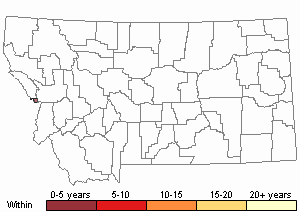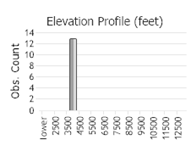View in other NatureServe Network Field Guides
NatureServe
Montana
Utah
Wyoming
Idaho
Wisconsin
British Columbia
South Carolina
Yukon
California
New York
Idaho Barren Strawberry - Waldsteinia idahoensis
Other Names:
Geum idahoense
State Rank Reason (see State Rank above)
Only one known site in Montana on National Forest land. Population is in an area susceptible to impacts from timber harvesting and road maintenance, though population appears to be stable or perhaps increasing in size.
- Details on Status Ranking and Review
Population Size
Score2-3 - Very Small to Small: Population size is imprecisely known but is believed to be <10,000 individuals.
CommentPrecise population levels unknown and species is a rhizomatous perennial which make estimates difficult. However, documenetd levels thus far are small.
Range Extent
Score3 - Local Endemic or Very Small Montana Range: Generally restricted to an area <10,000 sq. miles (equivalent to the combined area of Phillips and Valley Counties) or <6 Sub-basins (4th code watersheds) Range-wide OR limited to one Sub-basin in Montana
CommentEndemic to central Idaho and one documented location in extreme western montana.
Area of Occupancy
Score3 - Very Low: Generally occurring in 3 or fewer Subwatersheds (6th Code HUC’s).
CommentKnown from one location in Montana.
Environmental Specificity
Score1 - Moderate: Species is restricted to a specific habitat that is more widely distributed or to several restricted habitats and is typically dependent upon relatively unaltered, good-quality habitat (C Values of 5-7).
CommentHabitat does not appear to be especially unique or rare.
Trends
Score0-1 - Stable to Minor Declines:
CommentTrend data are lacking. However, it does not appear that the population has declined and the extent of the population may be increasing via vegetative reproduction.
Threats
Score1 - Medium: 11-30% of the populations are being negatively impacted or are likely to be impacted by one or more activities or agents, which are expected to result in decreased populations and/or habitat quality and/or quantity.
CommentNo specific threat or combination of threats appear to be severe in magnitude or immediacy. Timber harvesting, road maintenance and successional dynamics all have the potential to detrimentally impact the species, though none appear to be significant threats at this time.
Intrinsic Vulnerability
Score0-1 - Low to Moderate Vulnerability.
CommentDoes not appear to be especially vulnerable and spreads vegetatively.
Raw Conservation Status Score
Score
10 to 13 total points scored out of a possible 19.
General Description
Idaho Barren Strawberry is a strongly rhizomatous, sparsely hirsute, perennial herb. The leaves are basal, and the stipules are membranous, adnate, and forming a broad base to the slender, 5-12 cm petioles. The blades are cordate to suborbicular, shallowly 3- to 5-lobed, coarsely toothed, and 3-5 cm broad. Peduncles with 1 or 2 ovate-lanceolate, simple to 3-lobed bracts are located near the 2- to 7-flowered, lanceolate-bracted, loose cymes that are sparsely glandular-pubescent above. The hypanthium is narrowly obconic and 2-3 mm long; its lobes are spreading, triangular-lanceolate, and ca. 4 mm long. The petals are cream or yellowish in color, suborbicular, and 4-5 mm long. There are ca. 70 stamens equalling the petals and 2-4 pistils. The ovary and achene are canescent, and the style is puberulent near the base.
Phenology
Flowering in June.
Diagnostic Characteristics
This species is distinguished from other genera in the Rose Family by the calyx free of the ovaries but enclosing them. It resembles species in the Saxifrage Family, from which it differs by the presence of leaf stipules, stamens more than 10, and pistils more than 1.
Species Range
Montana Range
Range Descriptions

 Native
Native
Range Comments
An endemic restricted to north-central Idaho (Clearwater, Idaho, Shoshone Counties in Idaho), barely getting into Montana (Missoula County) with one occurrence (Michael Mancuso, personal communication 1999; Montana Natural Heritage Program, 1999).
Observations in Montana Natural Heritage Program Database
Number of Observations: 19
(Click on the following maps and charts to see full sized version)
Map Help and Descriptions
Relative Density

Recency



 (Observations spanning multiple months or years are excluded from time charts)
(Observations spanning multiple months or years are excluded from time charts)
Habitat
Open coniferous forest in the montane zone. Forest overstory consists of lodgepole pine, ponderosa pine and spruce.
National Vegetation Classification System Groups Associated with this Species
Forest and Woodland
Low Elevation - Xeric Forest and Woodland
Montane - Subalpine Forest and Woodland
Stewardship Responsibility
Threats or Limiting Factors
STATE THREAT SCORE REASON
Threat impact not assigned because threats are not known (MTNHP Threat Assessment 2021).
References
- Literature Cited AboveLegend:
 View Online Publication
View Online Publication MTNHP Threat Assessment. 2021. State Threat Score Assignment and Assessment of Reported Threats from 2006 to 2021 for State-listed Vascular Plants. Botany Program, Montana Natural Heritage Program, Helena, Montana.
MTNHP Threat Assessment. 2021. State Threat Score Assignment and Assessment of Reported Threats from 2006 to 2021 for State-listed Vascular Plants. Botany Program, Montana Natural Heritage Program, Helena, Montana.
- Additional ReferencesLegend:
 View Online Publication
View Online Publication
Do you know of a citation we're missing? Crawford, R. C. 1980. Ecological investigations and management implications of six northern Idaho endemic plants on the proposed endangered and threatened lists. Unpublished thesis, University of Idaho, Moscow. 200 pp.
Crawford, R. C. 1980. Ecological investigations and management implications of six northern Idaho endemic plants on the proposed endangered and threatened lists. Unpublished thesis, University of Idaho, Moscow. 200 pp. Crawford, R.C. 1983. Pacific yew community ecology in north-central Idaho with implications to forest land management. Ph.D. Dissertation, University of Idaho, Moscow.
Crawford, R.C. 1983. Pacific yew community ecology in north-central Idaho with implications to forest land management. Ph.D. Dissertation, University of Idaho, Moscow. Graf, P. E. 1974. Successional stages of red alder in Bonner County, Idaho. Unpublished thesis, University of Idaho, Moscow. 146 pp.
Graf, P. E. 1974. Successional stages of red alder in Bonner County, Idaho. Unpublished thesis, University of Idaho, Moscow. 146 pp. Lackschewitz, K., P. Lesica, and J. S. Shelly. 1988. Noteworthy collections: Montana. Madrono 35:355-358.
Lackschewitz, K., P. Lesica, and J. S. Shelly. 1988. Noteworthy collections: Montana. Madrono 35:355-358. Lesica, P., M.T. Lavin, and P.F. Stickney. 2012. Manual of Montana Vascular Plants. Fort Worth, TX: BRIT Press. viii + 771 p.
Lesica, P., M.T. Lavin, and P.F. Stickney. 2012. Manual of Montana Vascular Plants. Fort Worth, TX: BRIT Press. viii + 771 p. Lesica, P., M.T. Lavin, and P.F. Stickney. 2022. Manual of Montana Vascular Plants, Second Edition. Fort Worth, TX: BRIT Press. viii + 779 p.
Lesica, P., M.T. Lavin, and P.F. Stickney. 2022. Manual of Montana Vascular Plants, Second Edition. Fort Worth, TX: BRIT Press. viii + 779 p.
- Web Search Engines for Articles on "Idaho Barren Strawberry"





